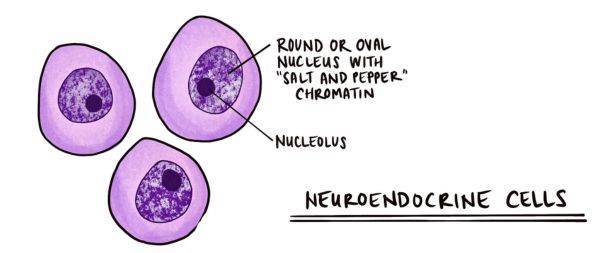Irrfan Khan, a name synonymous with versatility and talent, is best known for his remarkable performances in both Indian and International cinema.
His legacy, however, extends beyond his brilliant acting skills and includes a heroic battle against a neuroendocrine tumour.
His journey, while cut tragically short, is testament to his resilience, and a story that continues to inspire countless people around the globe.
Neuroendocrine Tumours

NETs are a group of rare, complex cancers that develop in the specialized cells of the body’s neuroendocrine system.
These cells perform specific functions, such as regulating the air and blood flow through the lungs and controlling the speed at which food is moved through the gastrointestinal tract.
They have traits of both nerve cells and hormone-producing cells, and can occur throughout the body but are most often found in the gut, pancreas, and lungs.
Classification of NETs
Neuroendocrine tumours can be classified as
- Functional
- Non-functional
depending on whether they produce excess hormones.
Functional NETs release hormones into the bloodstream, leading to specific symptoms such as flushing, diarrhea, and wheezing.
On the other hand, non-functional NETs do not produce hormones and are usually identified due to non-specific symptoms such as pain or a lump.
NETs can also be graded based on their growth rate, which is determined by the number of dividing cells (mitotic count) and the Ki-67 proliferation index.
The World Health Organization (WHO) classification grades NETs into G1, G2, and G3.
Symptoms of Neuroendocrine Tumours
NETs can occur in different areas of the body and their symptoms can vary widely depending on their location and whether they are functional or non-functional.
Functional NETs produce hormones that can cause specific symptoms, while non-functional NETs do not.
Common symptoms of NETs may include:
Flushing of the skin: Often seen with carcinoid syndrome (a condition caused by certain types of NETs), this is a redness of the skin that typically occurs on the face and upper chest.
Diarrhea: Frequent loose stools can occur, particularly in functional NETs, due to excess hormone production.
Abdominal pain or discomfort: Pain can be felt if the tumour grows large enough to press against other organs or tissues.
Wheezing or shortness of breath: This may occur if the NET is located in the lungs or if it produces hormones that affect lung function.
Heart palpitations: Some NETs may secrete hormones that can affect heart rate.
Weight loss: Unintentional weight loss can be a sign of various types of cancer, including NETs.
Fatigue: A general feeling of being tired or weak can be associated with cancer or the side effects of hormone secretion.
Skin rash: Some types of NETs, particularly those associated with Multiple Endocrine Neoplasia Type 1 (MEN1), can cause skin rashes.
High blood sugar levels (hyperglycemia) or low blood sugar levels (hypoglycemia): Some NETs, especially those in the pancreas, can produce hormones that affect the body’s insulin production, leading to fluctuations in blood sugar levels.
If you have any persistent symptoms that worry you, it’s essential to see a healthcare provider to get a proper diagnosis.
Diagnosis
The process of diagnosing NETs is complex and multifaceted, necessitating a diverse array of medical examinations and tests to confirm the presence and nature of the tumour.
These include:
Imaging Scans: They help medical practitioners visualize the tumour, determine its size, and identify its location. Common imaging techniques used include Computerized Tomography (CT) scans, Magnetic Resonance Imaging (MRI), and ultrasound. These scans can offer detailed images of the body’s internal structures and allow doctors to identify any abnormalities.
Blood and Urine Tests: Laboratory tests on samples of blood and urine are conducted to detect abnormal levels of hormones, a common indicator of NETs. These tests can often reveal if the tumour is functional, meaning it is producing excess hormones. Blood tests may also help monitor the general health of the patient, assess the function of organs such as the liver and kidneys, and detect other potential markers associated with NETs.
Hormonal Tests: If the NET is suspected to be functional, additional hormonal tests may be required. The specific hormones tested will depend on the symptoms and the suspected location of the tumour. These tests can be crucial in understanding the type of NET, guiding treatment decisions, and managing symptoms caused by excess hormone production.
Biopsy: A biopsy involves removing a small sample of tissue from the suspected tumour for closer examination under a microscope. This procedure is typically performed using a fine needle and guided by ultrasound or CT scan to ensure accuracy. A pathologist then examines the tissue sample to confirm the presence of cancer cells and can also determine the grade of the tumour, which helps in predicting its likely behaviour and guiding treatment decisions.
Advanced Imaging Techniques: For more detailed information about the tumour and to check if the cancer has spread to other parts of the body (metastasized), advanced imaging techniques such as Positron Emission Tomography (PET) scans may be used. A PET scan can provide a whole-body image and can detect areas of increased cellular activity, a common characteristic of cancer cells.
Treatment
The treatment of NETs is determined by several factors, including
- The size and location of the tumour
- Its grade (how abnormal the cells look under a microscope and how quickly the tumour is likely to grow and spread)
- Whether the tumour is secreting excess hormones, and whether it has spread to other parts of the body.
The patient’s overall health will also influence the treatment options.
Here are some common treatment strategies:
Surgery: This is often the first line of treatment for NETs if the tumour is localized and hasn’t spread to other parts of the body. The goal is to remove the tumour entirely, but in cases where this isn’t possible, debulking surgery may be performed to remove as much of the tumour as possible to relieve symptoms.
Hormone Therapy: For functional NETs that produce excess hormones, hormone therapy can be used to block the effects of the hormones and manage symptoms. This could involve the use of somatostatin analogues, which can help control the growth of NETs and manage symptoms associated with hormone overproduction.
Chemotherapy: Chemotherapy uses drugs to kill cancer cells or stop them from dividing. This treatment is typically used for aggressive or advanced NETs that have spread to other parts of the body.
Targeted Therapy: These are newer drugs that specifically target certain characteristics of cancer cells, such as a protein that allows the cancer cells to grow in a rapid or abnormal way. Examples include everolimus and sunitinib, which have been shown to slow the growth of certain types of NETs.
Peptide Receptor Radionuclide Therapy (PRRT): PRRT is a form of targeted treatment that delivers radiation directly to the cancer cells. It involves a substance that can bind to a certain part of the cancer cells (usually a hormone receptor), combined with a small amount of a radioactive substance.
Radiation Therapy: Although it’s not often used as a primary treatment for NETs, radiation therapy can be employed to relieve symptoms or to treat NETs if other treatments aren’t working or can’t be used.
Liver-directed Therapies: If the NET has spread to the liver, local therapies such as embolization (which blocks the blood flow to the tumour) might be used.
Watchful Waiting: For some slow-growing NETs, immediate treatment might not be necessary. Instead, the doctor might recommend careful monitoring of the tumour to determine if or when treatment should begin.
It’s important to discuss the available options, along with their benefits and risks, with the healthcare team in order to make an informed decision about treatment.
Ongoing research and clinical trials continue to explore new ways to treat NETs, with the aim of improving outcomes and the quality of life for patients with these complex cancers.
Living With
The Legacy of Irfan Khan

In March 2018, the world was shocked when Irfan Khan, known for his work in films like “The Lunchbox,” “Piku,” “Life of Pi,” and “Slumdog Millionaire,” announced that he had been diagnosed with a neuroendocrine tumour.
With honesty and a strength that would characterize his entire battle with the disease, Khan shared the news with his fans on Twitter, urging them to not speculate and promising to keep them updated about his health journey.
While it was indeed a high-grade cancer, Irrfan was determined not to let it dim his spirit. He flew to London for treatment, leaving behind his home, work, and loved ones in India.
Khan’s openness about his disease was inspiring, especially in a society where conversations about illness, particularly cancer, can often be shrouded in stigma and fear.
He made a point to share regular updates about his condition, acknowledging the emotional and physical challenges while also reflecting on the insights and personal growth he gained through his illness.
Throughout his treatment, Khan kept his spirit and his career alive.
During a brief period of respite from his disease, he returned to India and completed filming for “English Medium,” his last film, released in March 2020.
It was a testament to Khan’s passion for his craft and his relentless will, a shining example of his tenacity and strength.
Sadly, Irfan Khan’s health deteriorated again, and he returned to London for further treatment.
Despite the best medical care and his unwavering spirit, Khan passed away on April 29, 2020.
The news of his death was received with deep sorrow worldwide. Tributes poured in from fans, co-stars, and film critics alike, mourning the loss of an extraordinary actor and an equally exceptional human being.
Irrfan Khan’s story is not just about his battle with cancer. It is about an extraordinarily talented man who faced his life’s greatest challenge with bravery and grace, inspiring millions around the world in the process.
Through his courage and his dignified battle against cancer, Irrfan Khan had left us with a reminder to appreciate the simple joys of life, to maintain resilience in the face of adversity, and to always face life’s challenges with grace and strength.
Also Read






